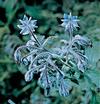- borage
-
/bawr"ij, bor"-, berr"-/, n.1. a plant, Borago officinalis, native to southern Europe, having hairy leaves and stems, used medicinally and in salads. Cf. borage family.2. any of various allied or similar plants.[1250-1300; ME burage < AF borage, bo(u)-rache, MF bourage < VL *burrago (LL burra hair stuffing + -go n. suffix)]
* * *
Large hairy annual herb (Borago officinalis), an ornamental species with large, rough, oblong leaves and loose, drooping clusters of starlike blue flowers.It is a member of the family Boraginaceae, which contains mostly herbs but also some trees and shrubs, all found in tropical, subtropical, and temperate areas and most concentrated in the Mediterranean region. Several other ornamental species are grown in gardens, including the Virginia bluebell (Mertensia virginica), forget-me-nots, heliotropes, and lungworts (Pulmonaria). Borage is also used as an herbal and bee plant and eaten as a vegetable. Borage (Borago officinalis).A to Z Botannical Collection/EB Inc.
Borage (Borago officinalis).A to Z Botannical Collection/EB Inc.* * *
▪ planta 60-centimetre (2-foot), hairy, annual plant with large, rough, oblong leaves and loose, drooping clusters of starlike, bright blue flowers. It belongs to the family Boraginaceae. The five bright yellow stamens form a cone at the star centre. Flowers are sometimes white or rose, and flowering stalks are usually reddish.Borage was native to the eastern Mediterranean region and was used by the ancient Greeks. It is cultivated today in various parts of Europe, Great Britain, and North America.The leaves of the borage plant have a cool, cucumber-like aroma and taste, and they are rich in calcium and potassium. Leaves and flowers are used in salads, and in Europe the leaves are cooked as a vegetable. Dried or fresh leaves are used to season stews and soups and to flavour wine cups and other drinks. Borage is also grown for bee feeding.* * *
Universalium. 2010.
